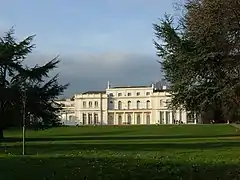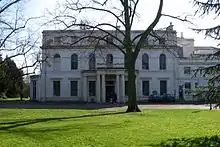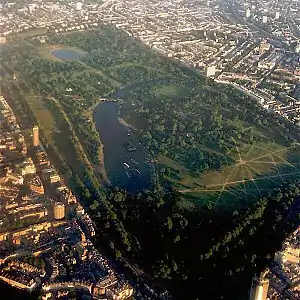Gunnersbury Park
Gunnersbury Park is a park in the London Borough of Hounslow between Acton, Brentford, Chiswick and Ealing, West London, England. Purchased for the nation from the Rothschild family, it was opened to the public by Neville Chamberlain, then Minister of Health, on 21 May 1926. The park is currently jointly managed by Hounslow and Ealing borough councils.[1] A major restoration project funded by the Heritage Lottery Fund was completed in 2018. The park and garden is Grade II listed.[2]
| Gunnersbury Park | |
|---|---|
 The Large Mansion at Gunnersbury | |
| Ceremonial county | Greater London |
| Region | |
| Country | England |
| Sovereign state | United Kingdom |
| Post town | LONDON |
| Postcode district | W |
| Dialling code | 020 |
| Police | Metropolitan |
| Fire | London |
| Ambulance | London |
History
Origins

The name Gunnersbury derives from Gunylda, the niece of King Canute who lived there until her banishment from England in 1044. The manor, owned by the Bishop of London, was occupied by the Frowyk family in the 15th century; Sir Thomas Frowyk, Chief Justice of the Common Pleas was born there in 1460.[3]
Early modern era
In the mid-17th century, Gunnersbury was acquired by Sir John Maynard, a lawyer and politician during the time of Cromwell.[4] It was he who in around 1663 built Gunnersbury House, a Palladian mansion modelled on the Villa Badoer, and designed by John Webb, the pupil and son-in-law of Inigo Jones. A map of Ealing dated 1777, shows the house in the north-east corner of the park, facing a horseshoe-shaped lake.[5]
The house was bought in 1739 from Maynard's great grandson John Hobart, 1st Earl of Buckinghamshire by wealthy merchant and MP Henry Furnese, after whose death in 1756 it was sold to Princess Amelia, the daughter of George II.[6]
Daniel Defoe visited Gunnersbury in 1742. He wrote: "...(The Mansion) stands on an eminence, the ground falling gradually from it to the Brentford Road; from the Portico…you have an exceeding fine prospect of the County of Surrey, the river Thames…and a good prospect of London in clear weather…"[7]
Princess Amelia
_by_Jean-Baptiste_van_Loo.jpg.webp)
In 1760, the house and estate were purchased for Princess Amelia, favourite daughter of George II. Plans for her to marry Prince Frederick of Prussia (who later became Frederick the Great of Prussia) had come to nothing, and when her father died, Amelia had lost her apartments at St James's Palace. She took a house in Hanover Square and used Gunnersbury House and estate as a country summer retreat. Amelia – George III's aunt, "that odd and hearty lady" – made Gunnersbury famous with her parties and political intrigues. The previous owner, Henry Furnese, had the grounds landscaped by William Kent in the 18th-century landscape style. Princess Amelia continued this, building a bathhouse in the grounds.[8]
19th century
After Amelia died in 1786, the estate had a number of owners. In 1788 it was acquired by Colonel Ironside, who sold it again in 1792 to a Walter Stirling. John Morley decided in 1801 to pull down the mansion and sell the land off piecemeal in 13 lots (the old house occupying Lot 2). The lots were eventually acquired by only two people, Alexander Copland (10 lots in 1802 and a further two in 1806), and Stephen Cosser (Lot 1 in 1802, sold to Major Alexander Morrison in 1807). Two separate estates were then established, each with its own new house. Copland, who bought 76 acres/30 hectares (most of the original grounds), was a builder and business partner of Henry Holland, and built the "Large Mansion" which was known, with its grounds, as "Gunnersbury Park".[9]
The "Small Mansion" was built virtually alongside in around 1806–1809, the builders evidently recognising the suitability of the position – an elevated terrace overlooking the horseshoe-lake near where the original mansion had stood. The small mansion and grounds were known as "Gunnersbury House".[10]
Rothschilds
In 1835, the merchant and financier Nathan Mayer Rothschild purchased the Large Mansion and park shortly before he died. The Small Mansion and its grounds were acquired in 1889 by the Rothschilds from the Thomas Farmer family (who had owned it since 1828), finally reuniting the original estate. The Rothschilds extended Gunnersbury further, acquiring most of the Old Brentford Common Field to the west, as well as land to the north. An old clay-pit in the south-west, "Cole’s Hole", was landscaped to become the Potomac lake, and the tile-kiln beside it modified to become a boat-house disguised as a gothic folly.[11] An orangery was built in 1836 to a design by Sydney Smirke.[12]
20th century
In 1925, following the death of Nathan's grandson Leopold de Rothschild, Leopold's wife, Maria, and son Lionel, sold the 200 acre/80 hectare Gunnersbury estate, which was entirely contained within the Brentford Urban District,[13] to the adjacent Ealing Borough Council and Acton Borough Council for £130,000. The land lay entirely outside their boundaries and the purchase was driven by snobbery. The "Queen of the Suburbs" did not want Brentford's municipal housing on its doorstep and the Mayor of Acton concurred, persuading her Borough Council to make it a joint purchase.[2]
Following the First World War, there was a demand for house-building land. In addition the construction of the Great West Road, immediately south of the estate, was attracting modern industries along its "Golden Mile". Lionel Nathan de Rothschild had purchased an estate at Exbury, Hampshire in 1919 and was investing in a fine woodland garden there, so selling off the Gunnersbury estate presented an attractive opportunity. Disgruntled Ealing ratepayers wrote to the papers complaining about the burden on their rate bills. The adjacent Brentford and Chiswick Borough Council commented that since Ealing already had The Common and several other parks, not to mention Kew Gardens close by, another park would be unnecessary. They insisted that the greater part of the land should be used for housing, and opposed the loan of the purchase money to Ealing and Acton from the Ministry of Health. However, "civic pride and snobbery prevailed", and the Rothschilds sold Gunnersbury on condition that it was only to be used for leisure and recreation – although of the 200 acres/80 hectares, 13 acres were allowed to be used for building houses along the Popes Lane and Lionel Road boundaries of the estate to raise funds to pay off the loan.[14]
When he opened the park on 21 March 1926, Neville Chamberlain "...rejoiced that the people had come into the possession of so magnificent and historical park..." He bemoaned the failure of earlier generations to recognise the need for open spaces in the towns and cities, when outdoor recreation was the privilege of the few.[15]
The large mansion was converted into an exhibition space for local history and archaeology, costume and fine art as the Gunnersbury Park Museum in 1929.[16] An adjoining area of Rothschild land just outside the Gunnersbury estate became the Gunnersbury Cemetery the same year.[17]
The park passed to the London Borough of Hounslow in 1965 and the Gunnersbury Park Joint Committee with Ealing was set up in 1967.[1]
21st century

A £50 million-pound, four-year restoration was completed in June 2018 with the reopening of the large mansion. The restoration was supported by the Heritage Lottery Fund, Ealing Council and Hounslow Council and English Heritage.[18] An outdoor sporting facility is due open to the public in 2020.[19]
In popular culture

The large mansion is quite recognisable as the venue for the police exhibition in the climax of the Ealing Studios comedy The Lavender Hill Mob filmed in 1951.[20]
In 1991 the London-based indie band The Hit Parade released their single "In Gunnersbury Park"; the song describes the failing relationship between songwriter J.Henry and his girlfriend who lived a short distance from the Park in Bollo Lane.[21]
In 2020, Gunnersbury Park and its museum served as the location of the music video of Liam Gallagher's single "Once".[22]
Gallery
 The small mansion with the large mansion in the background to the left
The small mansion with the large mansion in the background to the left The 18th-century temple
The 18th-century temple The boathouse on the Potomac
The boathouse on the Potomac The Orangery from the Horseshoe Pond after restoration
The Orangery from the Horseshoe Pond after restoration
References
- New approach for Gunnersbury Park Archived 16 July 2011 at the Wayback Machine, Hounslow London Borough Council, UK. Retrieved on 2 February 2008.
- Historic England. "Gunnersbury Park (1000808)". National Heritage List for England. Retrieved 19 August 2020.
- E. Foss, 'Frowyk, Thomas', in The Judges of England: With Sketches of their Lives, 9 vols (Longman, Brown, Green, Longmans and Roberts, London 1848–1864), V (1857), pp. 51–53.
- John Maynard in Dictionary of National Biography.
- Nichol’s Ealing parish map 1777
- Bolton, Diane K; Croot, Patricia E C; Hicks, M A (1982). "'Ealing and Brentford: Manors', in A History of the County of Middlesex: Volume 7, Acton, Chiswick, Ealing and Brentford, West Twyford, Willesden, ed. T F T Baker and C R Elrington". London: British History Online. pp. 123–128. Retrieved 19 August 2020.
- Defoe, Daniel (1779). A tour through the island of Great Britain, Divided into Circuits or Journies. 2. James Williams. p. 136.
- "Gunnersbury Park London W3: Historic environment assessment" (PDF). London Borough of Hounslow. 1 September 2013. p. 6. Retrieved 19 August 2020.
- Historic England. "Gunnersbury Park Museum (1358312)". National Heritage List for England. Retrieved 19 August 2020.
- Historic England. "Gunnersbury House (1080330)". National Heritage List for England. Retrieved 19 August 2020.
- "Gothic Boathouse, Gunnersbury Park, Gunnersbury Avenue – Hounslow". Historic England. Retrieved 19 August 2020.
- "Orangery". Visit Gunnersbury Park. Retrieved 19 August 2020.
- Great Britain Historical GIS / University of Portsmouth, Brentford UD (historic map). Retrieved {{{accessdate}}}.
- "The Covenant for Gunnersbury Park". Brentford TW8. Retrieved 19 August 2020.
- "The Official Opening of Gunnersbury Park by the Rt. Hon. Neville Chamberlain, M. P." British Film Institute. 21 March 1926. Retrieved 19 August 2020.
- "Gunnersbury Park Museum Archive". Archives Hub. Retrieved 19 August 2020.
- "Gunnersbury Cemetery". Royal Borough of Kensington and Chelsea. Retrieved 19 August 2020.
- "Colossal £50 million Gunnersbury Park restoration opens its doors in west London". Homes and Property. 20 July 2018. Retrieved 19 August 2020.
- "Gunnersbury Park Sports Hub". Retrieved 19 August 2020.
- "The Lavender Hill Mob (1951)". IMDB. Retrieved 19 August 2020.
- "In Gunnersbury Park".
- Glynn, Paul (31 January 2020). "Liam Gallagher acts as 'King' Cantona's butler" – via www.bbc.co.uk.
Further reading
- Collett-White, Ann and James, (1993) Heritage Publications, ISBN 978-1-899144-05-1.
- Rivis, Ronald Gordon Lockhart, (1960) The Gunnersbury Park Museum 1927–1955.
External links
| Wikimedia Commons has media related to Gunnersbury Park. |
- Friends of Gunnersbury Park & Museum website
- London Borough of Hounslow (2009) A guide to Gunnersbury Park today
- London Borough of Hounslow (2009) Gunnersbury Park
- London Borough of Hounslow Gunnersbury Park Museum



.svg.png.webp)